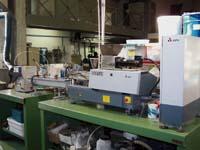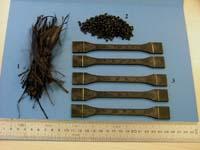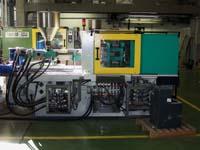After having damaged the pieces of planes...
2006/03/01 Kortabitarte Egiguren, Irati - Elhuyar Zientzia Iturria: Elhuyar aldizkaria

Currently, the only way to treat compound materials is by depositing them in authorized and authorized landfills. Faced with these needs, Inasmet-Tecnalia has developed a research project to prepare an innovative recycling technique. This technique has consisted, on the one hand, in the recovery of carbon fibre from the components considered as waste and, on the other, in the analysis of the possibilities of reuse as a reinforcement element.
In general, the composite materials used in aeronautics are composed of carbon fibers and epoxy resins. Carbon fiber is an expensive material, but also hard and light, so it is very used in the aeronautical industry. In addition to reducing the structural weight of the aircraft, composite materials require less assembly in the structure (rivets are avoided) and are easier to maintain.
The raw material and workmanship are expensive in the manufacture of large parts, require long development and a complex design. Both parties make that currently the structure of commercial aircraft
They are used in 20%. However, it seems that in the future this percentage will increase.

Three techniques
In Inasmet-Tecnalia three carbon fiber recovery techniques have been analysed. On the one hand, when dissolving the piece considered as a residue in nitric acid, it is observed that the resin is dissolved. In this way, carbon fiber has been separated by chemical digestion.
The second option has been based on thermal pyrolysis. The piece is heated to about 400 °C and the resin is burned. At this temperature the carbon fiber does not undergo any change. Finally, it has been analyzed the possibility of incinerating these materials to evaluate their energy value. For this purpose they have burned the piece in its entirety and have measured its calorific power. These data have been contrasted with the heat capacities of traditional fuels (wood, coal, fuel, etc. ). These three experimental techniques have been applied in the southern half of a small plane built in Inasmet-Tecnalia.
Another objective of the project has been to seek a potential application for recycled carbon fiber. For this purpose it has been combined with two thermoplastic resins very used in automotive, specifically polypropylene and polyamide. The researchers have measured various mechanical properties to assess the effect produced by the addition of recycled carbon fiber.

In all cases, a remarkable improvement in properties has been observed, since, regardless of the method used for recycling of the added fiber, thermoplastic is powered. However, the fiber obtained by digestion is the one that improves the properties of thermoplastics.
Economy and the environment
In addition to technical aspects, economic and environmental aspects must be taken into account. For the analysis of the economic criteria, an economic assessment of the treatment used has been carried out. In the chemical process, it is necessary to take into account the cost of nitric acid, the time of washing and drying of fiber and the treatment of waste. When done thermally, a fairly clean fibre is obtained, once the resin is burned. Only small carbonillas appear which are removed by agitation. It is a process faster than chemical digestion.
From the environmental point of view, the chemical process presents a series of difficulties, even if it is technically and economically viable. Nitric acid is toxic, so working with this type of products requires great safety measures. In addition, nitric acid should be heated to be more efficient. In this process, a series of volatile compounds that are contaminants are released.

Therefore, it is necessary to analyze previously if the process of recycling of carbon fiber will generate more or less waste. This is what happens in this chemical process. That's why it can't still be used on a large scale. Likewise, during the incineration process, nitrogen is emitted into the environment and it is observed that the calorific power of the fuel is low.
Therefore, as a main conclusion of the study, it can be affirmed that, although the three ways of obtaining carbon fiber analyzed are viable, from the environmental point of view, only the pyrolysis technique can be used to recover the carbon fiber on a large scale. The carbon fiber obtained is of good quality and can be used as a reinforcement in applications not contemplated to date. So far, it has not been carried out for its high cost.



